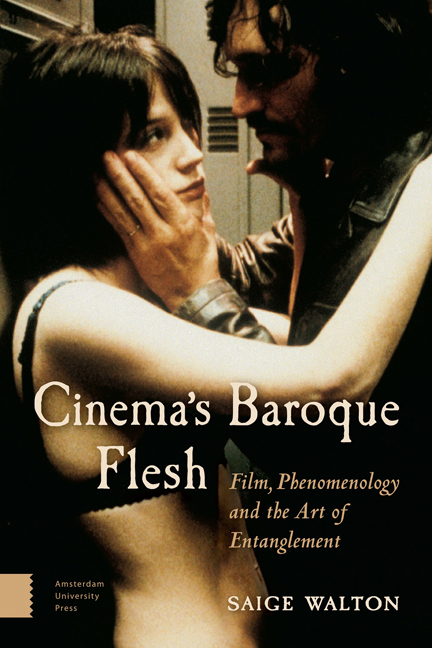Book contents
- Frontmatter
- Dedication
- Contents
- Acknowledgements
- Introduction
- 1 Flesh, Cinema and the Baroque: The Aesthetics of Reversibility
- 2 Knots of Sensation: Co-Extensive Space and a Cinema of the Passions
- 3 Baroque Skin/Semiotics
- 4 One Hand Films the Other: Baroque Haptics
- Conclusion: Or the Baroque ‘Beauty of the Act’
- Notes
- Bibliography
- Filmography
- Index
Conclusion: Or the Baroque ‘Beauty of the Act’
Published online by Cambridge University Press: 12 February 2021
- Frontmatter
- Dedication
- Contents
- Acknowledgements
- Introduction
- 1 Flesh, Cinema and the Baroque: The Aesthetics of Reversibility
- 2 Knots of Sensation: Co-Extensive Space and a Cinema of the Passions
- 3 Baroque Skin/Semiotics
- 4 One Hand Films the Other: Baroque Haptics
- Conclusion: Or the Baroque ‘Beauty of the Act’
- Notes
- Bibliography
- Filmography
- Index
Summary
The chiasm, reversibility, is the idea that every perception is doubled with a counter-perception […] an act with two faces, one no longer knows who speaks and who listens. Speaking-listening, seeing-being seen, perceiving-being perceived circularity (it is because of it that it seems to us that perception forms itself in the things themselves)—Activity=passivity.
– Maurice Merleau-Ponty (VI, pp. 264–265)In the above quotation, Merleau-Ponty captures the ontology of ‘flesh’ as ‘an act with two faces’ that is endowed with an inherent reversibility (VI, p. 264). Like the mobile and replenishable field of possibility that is ‘flesh’, the baroque hinges upon sensuous doubling. Baroque flesh entails a doubled or reversible structure that enlaces, intertwines, knots up, encroaches upon, or folds back the sensations of one body upon another to achieve the art of entanglement. In the baroque flesh of art and film, the ‘inside’ of our embodied perception exists in a correlative relationship with the ‘outside’ aesthetic expression. Generating a heightened continuum between bodies, baroque flesh takes great delight in a ‘sensuous flipping’ between the inside and the outside of the work by drawing our attention to its own formal construction, by reflecting upon its own perceptions and expressions or by foregrounding chiasmic scenarios of the sensing and the sensible (Bal, Quoting, p. 142).
As I indicated in my introduction, the baroque has typically been invoked as a stand-in for films that are stylistically excessive, idiosyncratic, visually overwhelming, or technologically resplendent. As such, the very notion of a cinematic baroque still tends to be conflated with a spectacular and/or technologically-driven optic. As a result, the full range of its aesthetic and embodied expressions and the ontological affinity that the baroque has in common with cinema has been elided. This book has sought to redress that scholarly gap by providing film and media studies with a new set of conceptual coordinates by which to understand the baroque and its relevance to cinema: baroque flesh. By examining its various formal, film-philosophical and embodied significances, I have argued that baroque cinema offers us a cinema of the senses and an especially vivid aesthetic concretization of Merleau-Ponty's ontology of ‘flesh’.
- Type
- Chapter
- Information
- Cinema's Baroque FleshFilm, Phenomenology and the Art of Entanglement, pp. 229 - 234Publisher: Amsterdam University PressPrint publication year: 2016



